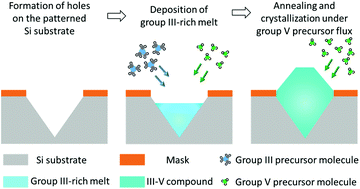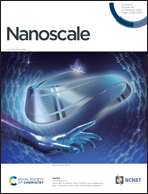Monolithic integration of InP on Si by molten alloy driven selective area epitaxial growth†
Abstract
We report a new approach for monolithic integration of III–V materials into silicon, based on selective area growth and driven by a molten alloy in metal–organic vapor epitaxy. Our method includes elements of both selective area and droplet-mediated growths and combines the advantages of the two techniques. Using this approach, we obtain organized arrays of high crystalline quality InP insertions into (100) oriented Si substrates. Our detailed structural, morphological and optical studies reveal the conditions leading to defect formation. These conditions are then eliminated to optimize the process for obtaining dislocation-free InP nanostructures grown directly on Si and buried below the top surface. The PL signal from these structures exhibits a narrow peak at the InP bandgap energy. The fundamental aspects of the growth are studied by modeling the InP nucleation process. The model is fitted by our X-ray diffraction measurements and correlates well with the results of our transmission electron microscopy and optical investigations. Our method constitutes a new approach for the monolithic integration of active III–V materials into Si platforms and opens up new opportunities in active Si photonics.



 Please wait while we load your content...
Please wait while we load your content...